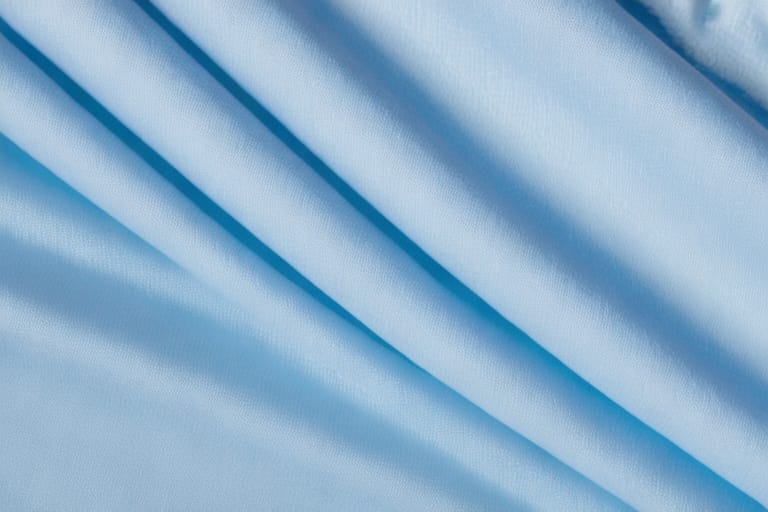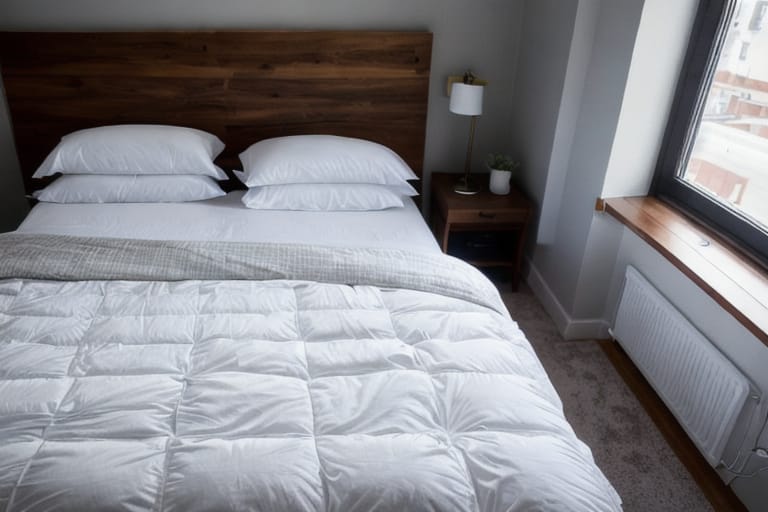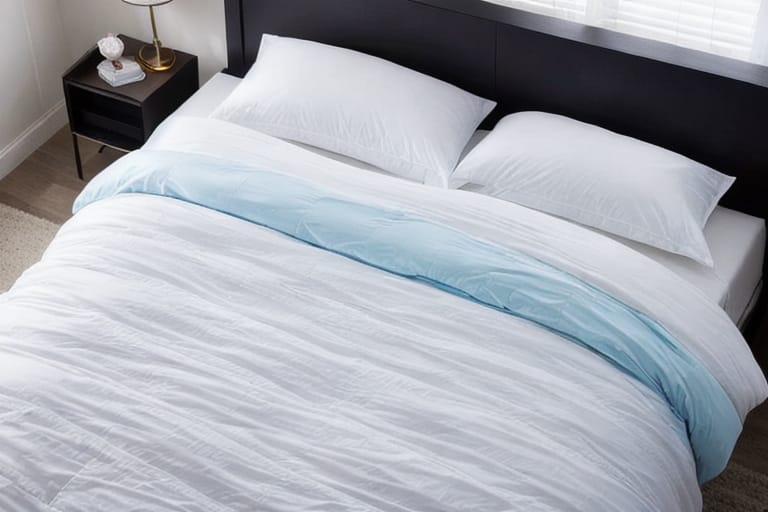Do you curl up under a down-filled comforter on chilly nights? These cozy bedding accessories provide unbeatable warmth and comfort. But have you ever wondered exactly how down comforters make their way from farm to bedroom?
Getting quality sleep is vital for health and wellbeing. The right bedding plays a major role in comfortable, restful sleep. As one of the most luxurious filling materials available, down has been used in blankets and bedding for centuries. Modern down comforters blend this old-world luxury with cutting-edge textile technology.
This beginner’s guide will walk you through the complete manufacturing process, from sourcing responsibly farmed down to stitching the final product. You’ll learn how factors like fill power, thread count, and baffle box construction impact comfort and durability.
Discover what really goes into making these snuggly blankets, and get tips for choosing the best down-filled bedding for your needs. Ready to become a down comforter expert? Let’s get started!
A Brief History of Down Bedding
Before delving into manufacturing methods, let’s go back in time.
- Goose and duck down has a long history of keeping people warm. Archaeologists found a down-stuffed quilt in a Pharaoh’s tomb dating back over 3,000 years!
- Across Europe and Asia, people filled textile pouches with feather and down to create warm bedding.
- When the first European settlers arrived in North America, they adopted the traditional bedding of Indigenous peoples: fur and down blankets.
By the early 20th century, technological advancements revolutionized down production for consumer markets.
- Down processing equipment like hammermills and silos created larger scale production.
- More precise sewing machines allowed intricate down comforter stitching.
- Knowledge of down’s unique properties expanded along with manufacturing capabilities.
Today down-filled bedding is a multi-billion dollar global industry, blending time-honored traditions with modern textile science.
Comparing Goose Down and Duck Down
The “down” inside a comforter comes from ducks and geese. But what’s the difference, and does it matter?
Goose down generally has better insulation properties than duck. The clusters trap more air, providing better coverage with less weight.
- Goose down can achieve an 800+ fill power. This means less down is required to make a comforter with ample warmth.
- It also compresses well and regains loft after being compressed. This makes goose down bedding convenient for storage.
Duck down has slightly different properties.
- Duck down maxes out at around a 650 fill power. So duck down comforters need more filling to achieve equal warmth.
- The clusters are generally not as fine and fluffy. So they don’t capture air as efficiently by volume.
However, comforters filled with 100% duck down provide perfectly adequate warmth at a budget-friendly price point. For many consumers, the moderate cost savings outweigh the performance benefits of goose down.
Understanding Fill Power Ratings
Fill power measures the quality and insulation ability of down. Most down comforters have a fill power between 400-900. What does this fill power rating actually mean?
Essentially, fill power measures the volume occupied by one ounce of down. An ounce of 800 fill power down will expand to fill 800 cubic inches of space (about the size of a volleyball).
Higher fill power numbers indicate:
- Better loft and insulation properties
- Increased air trapping capacity
- Lighter weight relative to warmth
- More resilience and durability over time
Compare how much less space one ounce of lower quality 400 fill power down fills:
As a lightweight insulator, nothing beats 800+ fill power goose down. But the highest grades come at a premium cost. For budget hunters, even lower fill powers provide noticeable benefits over other insulating materials.
Why Ethical Sourcing Matters

The path from farm to factory impacts down quality and comforter performance. Sourcing methods also carry serious ethical implications.
Live-plucking illegally harvests down feathers from live geese. This inhumane practice still persists on some farms seeking to cut costs. Choosing ethically sourced down helps combat live-plucking. Certification programs like the Responsible Down Standard audit supply chains for animal welfare violations.
Consumers should look for DOWNMARK® Certified labels. DOWNMARK® traces down through each step of production, verifying humane treatment. Brands like Western Quilts carry DOWNMARK® certified collections.
Sourcing methods also affect down quality. Hand-harvesting performed with care maximizes cluster integrity. Hand-collected down generally achieves higher resilience and fill power.
Advanced Processing Creates Premium Down
Collecting down is just the first step. Transforming raw feathers into a luxury filling requires advanced processing.
Cleaning and Separating
Mills wash the down repeatedly to eliminate dirt and allergens. Next, the fluffy feather layer gets separated from the heavier, coarse strands. This leaves only the lightweight clusters best suited for bedding.
High temperature sterilization eliminates dust and remaining allergens. At this stage processors may also sort down into batches based on cluster size and quality. This allows creating custom blends based on desired features.
Achieving Consistent Fill Density
To pour evenly into comforters, loose down needs uniform thickness. This step inspired the construction of “down silos” starting in the 1950s.
Down Conditioning Silos
- Resemble grain silos up to 40 feet tall
- Funnels at the bottom meter out down like sand through an hourglass
- Rotating paddles blend down to homogenize texture
- Conditioned down flows freely into boxes for transport
Gooseneck Filling Technology
The next innovation? Flexible hoses dubbed “goosenecks”. Attached to silos, these hoses allow workers to pipe conditioned down directly into quilted comforters.
Goosenecks enabled precision fill levels unmatched by hand-filling methods. They remain standard equipment in factories today.
Quilted Shell Construction
With clean, safeguarded down at the ready, constructing the comforter shell is next. This quilted outer layer contains the delicate fill.
High thread count fabrics promote both durability and breathability. Common shell materials include:
- Egyptian or Pima cotton – breathable, soft, and durable
- Sateen cotton – lustrous shine resists pilling
- Silk – lightweight with moisture wicking properties
- Percale cotton – matte finish stands up to frequent washing
Beyond material, specialized construction transforms fabric into an insulating down holder.
Box Baffle vs Sew-Through: Comparing Construction
Box baffle construction adds structure for even down distribution:
- Fabric folded into empty pockets
- Vertical baffle boxes run length of comforter
- Reinforced with double or triple stitching
- Minimizes cold spots and shifting
Sew-through comforters feature simpler construction:
- Top and bottom fabrics stitched together
- Parallel rows create channels to contain down
- More prone to shifting and cold spots
- Budget-friendly price point
For most consumers, baffle box designs provide better performance and durability to justify the cost. But sew-through comforters still offer quality insulation for the price.
Add the Finishing Touches

After choosing fabrics and construction, workers meticulously assemble each comforter.
- Fabric sheets layered then marked for precise cutting
- Shell pieces aligned and tacked in place
- Reinforcing tape edgestitched around perimeters Adding on duvet loops and corner ties completes the quilted shell. It’s ready for the final step: filling.
Filling: Achieving the Perfect Amount of Fluff
You can’t have a down comforter without down. Filling the stitched shell requires care and experience.
Fill weight measures the amount of insulation inside a comforter. This generally ranges from 15 oz for lightweight summer bedding up to 60 oz for extra warmth.
Comforters with less fill feel thinner and compress down with body weight. Heavier fill provides billowy thickness cushioning sleepers. The “just right” fill level depends on seasonal needs and personal preferences.
Gooseneck fill tubes allow precise fill amounts for each zone of the comforter. Workers weave the flexible hoses throughout the quilt, injecting continuous streams of down. They distribute and blend the filling until reaching uniform, lofty thickness.
Caring for Down Bedding
Once home with your cozy new down comforter, proper care is essential for longevity.
We recommend professional laundering 1-2 times per year. The experts can gently wash and completely dry the down without damage.
Between deep cleanings follow these tips:
- Spot clean stains with mild detergent
- Fluff the comforter 2-3x per month
- Air out the down after nights of heavy sweating
- Store folded or rolled up in a breathable bag
Down vs Down Alternative Comparison
For allergy sufferers or vegans, down alternative comforters offer similar warmth without animal products.
Down alternative filling uses:
- Primaloft – ultra-fine polyester fibers
- Ecodown – recycled PET plastic bottles
- Kapok – silky plant-based fibers
| Goose Down | Down Alternative | |
|---|---|---|
| Durability | Excellent – lasts over 10 years with care | Good – retains loft 5+ years on average |
| Warmth | Outperforms all other insulators per ounce | <ul><li>Nearly as insulating as quality down</li><li>Must use more fill for equal warmth</li></ul> |
| Allergies | Allergy sufferers often react to proteins in down | Hypoallergenic, no animal allergens |
| Price | $$$ – Highest quality down is expensive | $-$$ More affordable, cheaper to produce |
| Environmental Impact | Sourcing goose down raises animal welfare concerns | Made from recycled/sustainable materials |
When Is the Best Time to Buy a Down Comforter?
Shopping for bedding often means sifting through seasonal sales. For the steepest discounts on down comforters, plan to buy at two key times:
1. January: Retailers clear inventory after the holidays with White Goose Down comforters up to 60% off.
2. September: Back to school sales can discount down bedding by 40-50%. Stock up on year-round lightweight options in the fall.
Outside of these seasonal promos, mark your calendar for three-day weekends. Holiday weekends like Labor Day and Memorial Day also attract shoppers with bed, bath and home sales.
Do You Really Need to Spend $500+ on Down Bedding?
When buying any household item, determining the right budget makes balancing cost and value easier. Luxury 800 fill power down comforters with baffle boxes and certified humane down fill impress. But with premium prices reaching upwards of $2,500 for a queen size, who really needs to spend that much?
The good news is excellent quality down bedding available without emptying your savings account. Here is what to expect at different price points when shopping for a queen size down comforter:
Under $150:
- Lower fill power down (500-550)
- Possible duck down instead of goose
- More prone to cold spots
- May require more frequent replacing
$150-$300:
- Goose down with 600-650 fill power
- Good mid-range warmth
- Potentially mixed with feather fill
- Usually sewn-through construction
$300-$500:
- Goose down around 700 fill power
- Baffle box design
- Higher thread count shell fabrics
- Use exclusively down clusters
- Lasts over 5 years with proper care
Here’s the bottom line: well-made mid-range down comforters in the $300-500 range balance quality, comfort and value. Splurging over $1,000 buys minor performance upgrades over standards most sleepers already love.
Which Down Comforter Brands Are the Best?
With hundreds of bedding brands on the market, how do you identify the cream of the crop? Over decades, a few down comforter manufacturers have risen to the top. Customers return again and again thanks to their quality craftsmanship and generous warranties.
Based on reputation, premium materials, and customer satisfaction, here are five of the best down comforter brands to know:
1. Scandia Down
- Specializes exclusively in down bedding
- Family-owned since 1964
- White Goose Down with baffle box construction
- 650 fill power comforters under $200
2. Brooklinen
- Direct-to-consumer bedding brand
- 670 fill power down wrapped in 330 thread count cotton
- “All-season comforters” with adjustable fill levels
- Strong customer satisfaction guarantee
3. Snowe Home
- Certified humane WHITE GOOSE DOWN
- 800 fill power in lightweight options
- 500 fill alternatives available
- Returnable comforters if not satisfied
4. Buffy Cloud
- Featured on Oprah’s “Favorite Things” list
- Made from 100% recycled materials
- 700 fill power down or EcoDown alternative
- Ultra-soft eucalyptus shell fabric
5. Parachute Home
- 700 fill power European down
- Percale cotton shell fabric
- Hand washable
- 90-night risk-free return policy
While not exactly budget-friendly, these reputable brands all offer high quality down bedding that lasts. Their satisfaction promises give confidence to invest in better sleep.
Become a Down Comforter Expert
That wraps up our beginner’s guide to the manufacturing behind these cozy bedding staples!
Here are the key takeaways:
- Responsibly sourced down combined with high tech processing creates premium comforter fill
- Baffle box construction evenly distributes fill while quality shell fabrics provide durability
- Higher fill powers mean better insulation yet mid-range options still sleep comfortably
- With proper care a quality down comforter can last over a decade
Now that you know what really goes into making the world’s best bedding, you can upgrade your sleep setup confidently. Stay cozy and sleep soundly!
Frequently Asked Questions
What exactly is fill power and why is it so important?
Fill power measures the volume one ounce of down fills up. Higher numbers mean the down is more lofty and efficient at trapping air. Premium goose down can reach 800+ fill power, offering maximum warmth for light weight. Most quality down comforters range from 600-800 fill power.
Does the type of shell fabric really make a difference?
The textile enclosing the down insulation absolutely affects comforter performance. High thread count Egyptian or Pima cotton, sateen, and even silk feel luxuriously soft while resisting leaking feathers. More budget-friendly percale cotton shells offer durability at cheaper prices.
What’s the benefit of baffle box construction vs. sew-through?
Vertically stitched baffle boxes running through the comforter keep the fill evenly distributed. This prevents cold spots while reinforcing the structure long-term. Sew-through comforters with simple stitching between the top and bottom layers do allow some shifting. But sew-through style costs less, with insulation nearly as cozy.
Is it worth paying more for goose down vs cheaper duck down?
If money is no object, spring for goose down and indulge in that dreamy softness. The larger clusters trap more air so less fill offers equal or superior warmth. But more budget-friendly duck down still makes an excellent insulator, just with slightly more weight for the same toastiness.
What’s the best way to clean my down comforter at home?
We recommend professional laundering 1-2 times per year to deep clean. For home care in between, gently spot treat stains then let the comforter air dry fully. Fluff the down with some quick kneading when it seems flat. And store in a large breathable cotton bag. Keeping your down bedding fresh doesn’t require frequent intensive washing.








